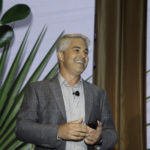If you spend time online, you’ve undoubtedly heard of cult-favorite beauty brand Glossier. Moreover, you’ve probably seen their ultra-chic and Instagram-worthy pink and vibrant red branding not on an ad, but in the social content of someone you know. Glossier’s community of raving fans is a large part of what drives their brand awareness, with individuals sharing their beauty routines with the world via social media. This loyalty and passion stem from the customer experience Glossier creates. As a direct to consumer brand, Glossier takes a unique approach to customer experiences beyond your typical beauty counter which has helped propel their digital marketing in unique ways.
Ali Weiss, SVP of Marketing at Glossier, gave the CommerceNext crowd insight into the inception of this community. Rooted originally in the beauty blog, Into the Gloss, Glossier arose as a customer-first beauty brand in response to a readership who came back time and again, not so much for the product recommendations, as for the people applying them. The participatory nature of their readership fueled the inception of Glossier, a beauty brand entirely marketed around the creation of customer experiences.
Glossier’s three foundational elements include product, digital, and offline experiences inspired by their readership and the foundational community that Glossier has fostered based on the idea that the consumer is the expert of their own routine. As a digital-first direct to consumer brand, Glossier sees 80% of its revenue from purchases. Their digital experience is fostered in the spirit of their founding blog, Into the Gloss, where readers come to share with one another, not just the products they use, but how they use them. The 30-skew product range of skincare, makeup, body products and fragrance is curated to create a product experience that changes the way these individuals participate in beauty, according to Weiss. By placing their community of fans at the forefront of product development as the experts of their skincare and makeup routines, Glossier has generated a product experience fuelled by the input of their followers.
Weiss shared two case studies with us in which her team at Glossier took community insight head-on, generating products based on demand and suggestion rather than suggesting them to the audience themselves, as so many beauty brands do. Glossier’s chemical exfoliant, The Solution, began as a conversation with the community to gain insight into what these individuals knew about exfoliation, what they were looking for in a product, and how they wanted their skin to look and feel. In taking this community insight head-on, Glossier was able to tap into their internal resources and create products based on what their followers were looking to add to their routine. Then, in marketing the product, Glossier continued to let the community hold the reins: their marketing strategy relied heavily on allowing their followers to share their experiences with the product, gifting a bottle of Solution to 100 of their community members and sharing about 60 of the stories they received as the herald of the product release.
Glossier continues to place customer experience and input at the forefront of their product development and marketing efforts; Weiss noted that the creation of their cult-favorite mascara, Lash Slick, was entirely informed by the overwhelming requests and vote of confidence for an end-all-be-all mascara; their community believed that, based on their experiences with the rest of the Glossier range, that they could make the best mascara on the market. Leading up to the retail launch of Lash Slick, Glossier sent a batch of the product to some of the individuals who requested and suggested the product on social media, along with a printout of their tweet. The reinforcement of this kind of feedback and result within the Glossier community largely fuels its own growth as well as the growth of the Glossier range and brand.
Inextricably linked to their product experiences are the digital routes by which the Glossier customer receives and learns about their product. What Weiss calls the “G Team” takes up a large part of their marketing squad and serves as an incredibly attentive and personalized sector of customer service. The G Team is designed to not only assist with e-commerce channels but to develop a personal relationship with each individual client and help them find the best products for their routines. The G Team is responsible for maintaining and scaling these one-on-one relationships, sharing information on shipping, brand love, brand questions, shade and product info, and improving the overall customer experience of direct to consumer sales within their online channels.
Glossier’s online presence, made up of editors from around the world, hinges on scaling these relationships between Glossier’s team and the community, as well as between the members of the communities themselves. Their digital marketing strategies rest largely on the content and feedback generated by micro-communities within the Glossier fan base, fuelling engagement beyond traditional marketing efforts. By allowing their community members to share their feedback and their routines, much like the interviewees on the founding blog, Glossier incorporates them as stakeholders in the development of the company.
Finally, Glossier’s third and final foundational element sits within their offline experiences. The brand now has two permanent brick-and-mortar experience stores in LA and New York City, combining the physical retail experience with the kind of community and experimentation that has become synonymous with the brand. Customers engage with what Weiss calls “editors” at their flagship locations, reaffirming the idea that each individual has a point of view when it comes to products, routines, and experiences with the brand. Glossier has executed or planned a total of five large-scale pop-ups in 2019 alone, each incorporating the local flavor into the customer experience. Glossier saw a conversion rate of over 50% from visitors to their physical retail locations, with over 50,000 visitors per month. The bulk of the hype surrounding these locations stems from community feedback as well, taking on feedback for how these individuals want to see Glossier not just pop-up, but exist and incorporate into their localized spaces.
The goals of the Glossier team are first and foremost to deliver on customer experience first, allowing all of their channels to follow suit, creating a platform for their community to share their routines and experiences themselves. Weiss notes that in their endeavors towards growth, they target not only revenue but also continued the love for the brand with each product launch and customer touchpoint experience, fostering a feeling that each is created especially for their community.
You can catch Ali Weiss’s full talk from CommerceNext 2019 on Youtube here.
Related Posts
-
The Power of Storytelling as a Customer Acquisition Strategy
With three years of mattress marketing backed by nearly thirty…
-
How Retailers Are Investing In Digital Customer Experience
Time is the most precious resource. Within our twenty-four hour…
-
How Walmart Adapts Customer Experience for the Digital Shopper
Walmart.com is anything but basic. The retailer is perhaps best…




